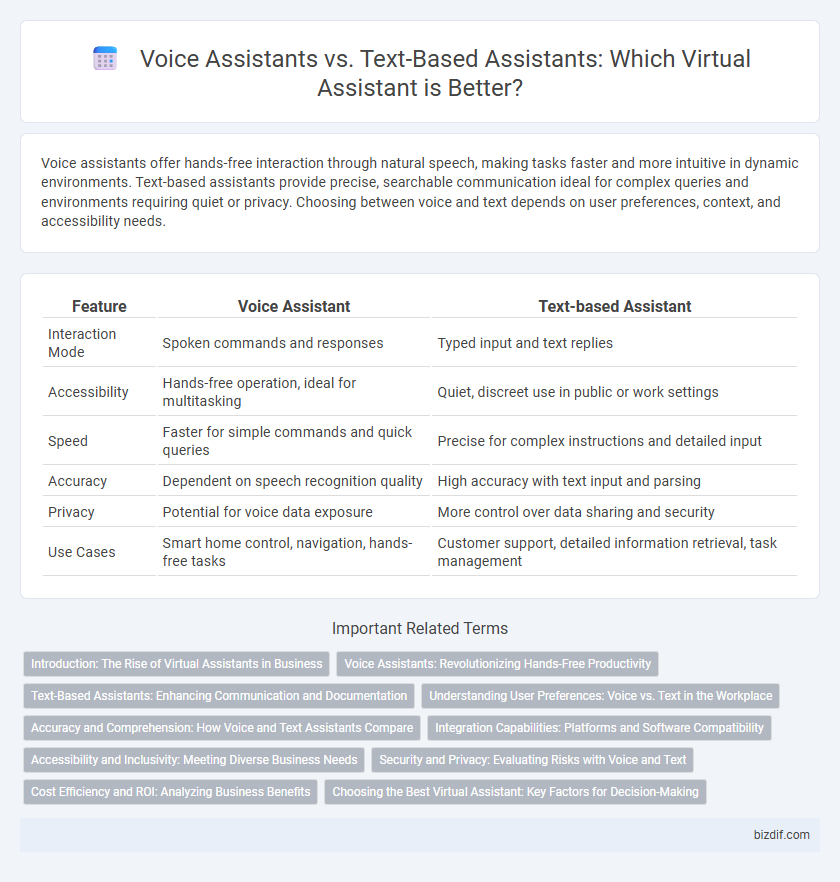Voice assistants offer hands-free interaction through natural speech, making tasks faster and more intuitive in dynamic environments. Text-based assistants provide precise, searchable communication ideal for complex queries and environments requiring quiet or privacy. Choosing between voice and text depends on user preferences, context, and accessibility needs.
Table of Comparison
| Feature | Voice Assistant | Text-based Assistant |
|---|---|---|
| Interaction Mode | Spoken commands and responses | Typed input and text replies |
| Accessibility | Hands-free operation, ideal for multitasking | Quiet, discreet use in public or work settings |
| Speed | Faster for simple commands and quick queries | Precise for complex instructions and detailed input |
| Accuracy | Dependent on speech recognition quality | High accuracy with text input and parsing |
| Privacy | Potential for voice data exposure | More control over data sharing and security |
| Use Cases | Smart home control, navigation, hands-free tasks | Customer support, detailed information retrieval, task management |
Introduction: The Rise of Virtual Assistants in Business
Voice assistants enhance business efficiency through hands-free interaction and real-time response, making multitasking seamless. Text-based assistants offer precise, searchable communication that supports detailed queries and asynchronous workflows. Both technologies revolutionize customer engagement by providing tailored support and improving operational productivity.
Voice Assistants: Revolutionizing Hands-Free Productivity
Voice assistants like Amazon Alexa, Google Assistant, and Apple Siri enable hands-free productivity by interpreting natural language commands and performing tasks such as setting reminders, sending messages, and controlling smart home devices. These AI-powered voice recognition systems improve efficiency in multitasking environments, offering faster interaction compared to text-based assistants. Voice assistants leverage deep learning and natural language processing (NLP) technologies to enhance user experience, making them essential tools for seamless, hands-free task management.
Text-Based Assistants: Enhancing Communication and Documentation
Text-based assistants excel at enhancing communication and documentation by providing precise, written interactions that can be easily reviewed and referenced. These assistants support complex queries, enable seamless integration with email and messaging platforms, and facilitate detailed record-keeping. Their ability to maintain conversation history and generate accurate transcripts improves collaboration and efficiency in both professional and personal contexts.
Understanding User Preferences: Voice vs. Text in the Workplace
Voice assistants excel in hands-free multitasking environments, providing quick, natural language interactions ideal for dynamic workplace settings. Text-based assistants offer precise control and privacy, enabling detailed query input and discreet communication in noise-sensitive or confidential situations. Understanding user preferences involves balancing efficiency, context sensitivity, and comfort, ensuring seamless integration of voice and text tools to optimize productivity in varied office workflows.
Accuracy and Comprehension: How Voice and Text Assistants Compare
Voice assistants demonstrate rapid processing of natural language but can struggle with accents or ambient noise, impacting accuracy. Text-based assistants excel in comprehension by analyzing precise written input, reducing misinterpretation risks. Both rely on advanced NLP algorithms, yet text interfaces typically provide higher accuracy in understanding complex queries.
Integration Capabilities: Platforms and Software Compatibility
Voice assistants excel in smart home device integration and hands-free control across platforms like Amazon Alexa, Google Assistant, and Apple Siri. Text-based assistants offer greater compatibility with enterprise software such as Slack, Microsoft Teams, and CRM systems, enhancing workflow automation. Both assistive types support multi-platform functionality, but voice assistants prioritize IoT environments while text-based solutions better serve professional communication and productivity tools.
Accessibility and Inclusivity: Meeting Diverse Business Needs
Voice assistants enhance accessibility for users with visual impairments or limited mobility by enabling hands-free interaction through natural language processing. Text-based assistants cater to environments where silence is essential or for users who prefer written communication, ensuring inclusivity for individuals with hearing impairments. Incorporating both voice and text-based virtual assistants allows businesses to meet diverse customer needs, fostering an accessible and inclusive digital experience.
Security and Privacy: Evaluating Risks with Voice and Text
Voice assistants require continuous listening, increasing the risk of accidental data capture and unauthorized access, while text-based assistants offer more controlled input environments, reducing exposure to eavesdropping. Encryption protocols and secure storage are critical for both, but voice data is more susceptible to interception during transmission. Robust authentication methods, such as multi-factor authentication, enhance security for text interactions, whereas voice biometrics can improve voice assistant privacy but may still face spoofing challenges.
Cost Efficiency and ROI: Analyzing Business Benefits
Voice assistants reduce operational costs by enabling hands-free, multitasking interactions, enhancing workforce productivity and decreasing time spent on routine tasks. Text-based assistants offer cost-effective deployment with lower development expenses and scalability, making them ideal for businesses prioritizing quick ROI in customer service automation. Combining both allows companies to optimize overall ROI by balancing user preference and technological investment tailored to specific business needs.
Choosing the Best Virtual Assistant: Key Factors for Decision-Making
Voice assistants excel in hands-free, real-time interaction, making them ideal for multitasking environments and accessibility needs. Text-based assistants offer precise, searchable communication and are preferred for detailed queries or environments where silence is essential. Key factors in choosing the best virtual assistant include context of use, user preference, and specific task requirements to optimize efficiency and user experience.
Voice assistant vs Text-based assistant Infographic

 bizdif.com
bizdif.com